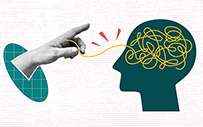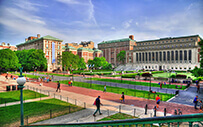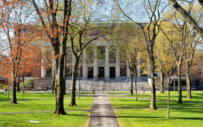
In spring 2025, NACE conducted a follow-up poll to a 2023 survey to better understand the current mental health concerns of NACE members. In the latest poll, more than half of participants self-reported that their mental health was worse at the time of the poll than it was last year at the same time.

Career center budgets for the 2024-25 academic year have increased across the board since 2022-23, according to results of NACE’s 2024-25 Career Services Benchmarks survey.

Attendance numbers reflect the preferences employers and students have for the format of career fairs, results of NACE’s 2024-25 Career Services Benchmarks survey reveal.

More than 200 senior career services leaders took part in a March 5 virtual meet up hosted by NACE to discuss effects of the Trump administration’s recent executive orders and “Dear Colleague” letter on the profession.

Designed to help NACE members with strategic planning and positioning, the 2025 environmental scan provides a current view of the landscape as it relates to career development and the early career talent recruiting space. The scan includes current demographic data as well as projected data and special survey data of the past year.

As students of color, including Hispanic students, are eager to attend higher education institutions and advance their economic wealth, many barriers hinder their academic success.

Because faculty are frequently asked by their current and former students for career advice, there is an opportunity to increase awareness among faculty of the resources available to them.

The political and social unrest seen on college campuses last spring and that may potentially reignite this fall has little impact on college recruiting, according to results of a recent NACE quick poll.

The NACE Liberal Arts Affinity Group reflects on its many accomplishments since last year's conference and looks ahead to next year.

Results of a NACE quick poll identify barriers and accelerators affecting the career paths of career services and university recruiting professionals.

Belonging at work—feeling that one is valued, accepted, and supported—helps to ensure a healthy, productive, and positive work environment. NACE surveyed its membership to better understand their experiences with belonging in the profession.

In an ever-evolving landscape, career services needs to adapt and innovate. Here, Hassan Akmal discusses how career services can reimagine itself to meet the needs of students and alumni.

In this op ed piece, Chris Miciek discusses problems with jumping into AI without considering the consequences and urges we take the middle ground.

The National Association of Colleges and Employers (NACE) polled its career services members in spring 2023 about their use of AI in their work and in their work with students.

More than 80% of schools conducted first-destination surveys in 2021-22, according to NACE’s 2021-22 Career Services Benchmarks Survey Report.

Career centers are being housed less frequently in student affairs, more frequently in other divisions, and increasingly in various parts of the institution.

Among respondents to a recent NACE quick poll, more than half of the association’s employer members and more than two-thirds of its college members reported experiencing burnout.

Career fairs are one of the most frequently provided services by college career centers, as 91.7 percent reported hosting at least one career fair in 2017-18.

A study conducted at Ohio University shows the power and potential of machine learning to predict and influence employment at graduation.

The current drive to better understand and anticipate the future of career services may be distinctive in that it is influenced by certain environmental factors that threaten a potential sea change in higher education.

Given the increased attention to career outcomes from both government and university administrations, one would expect a significant commitment on the part of the university to the career services office. This commitment could be measured in terms of critical resources expressed as either added dollars or increased personnel to handle the increasing difficulty of counseling students to succeed in a depressed job market. Using data from two installments of NACE’s annual Career Services Benchmark Survey for Colleges and Universities (2007 and 2014), this article examines the strength of that commitment.

There is very little differentiation in the average salaries for each of the career services positions until one gets to the management level.

The guarded optimism of early June has faded into the reality that the COVID-19 pandemic has had a significant impact on college enrollments for the fall.


Research illustrates the hit that career center budgets took during the pandemic, as more than one-third of career centers reported cuts to their personnel budgets.

It’s not surprising that fees for in-person career fairs were down sharply in 2020-21 compared to 2019-20, but the charges for hybrid fairs jumped for some employers.

Qualitative research conducted with 12 markedly different colleges and universities identifies the factors that led to the elevation of the career services operation.

NACE is polling employers and career services professionals on their plans for fall 2021 in light of the pandemic and greater opportunity to return to in-person interactions. The polls run July 27 through August 20, 2021, and results are offered in real time.

Most career services offices plan to hold both in-person and virtual career fairs this fall, but many employers expect to hold their own virtual events.

Research shows a greater number of career services units are moving away from their traditional homes in student affairs divisions; this article explores the root causes behind the trend and uses the University of California, Irvine to illustrate what this shift might mean for universities exploring career services realignments on their campuses.

College career services offices have changed the ways they engage employers and students from historically marginalized groups during the COVID-19 pandemic.

While the COVID-19 pandemic caused many adjustments to the ways career services offices operate, they did not make substantial changes to their employer relations strategy.

Over the last two years, the nature of employment has shifted, and college career services may need to adjust to more closely align with these changes.